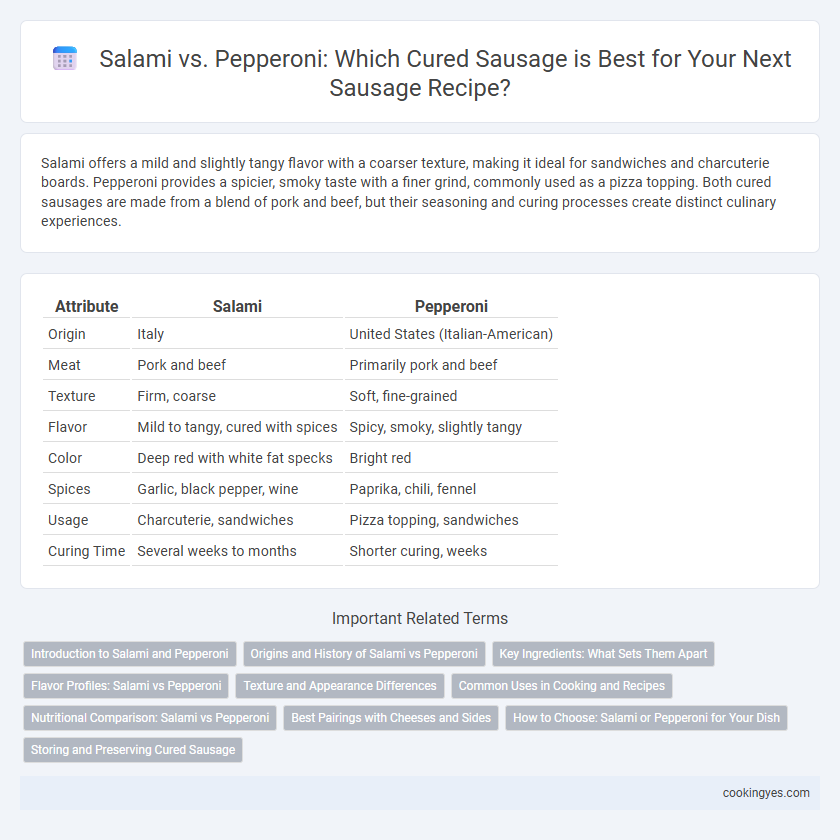Salami offers a mild and slightly tangy flavor with a coarser texture, making it ideal for sandwiches and charcuterie boards. Pepperoni provides a spicier, smoky taste with a finer grind, commonly used as a pizza topping. Both cured sausages are made from a blend of pork and beef, but their seasoning and curing processes create distinct culinary experiences.
Table of Comparison
| Attribute | Salami | Pepperoni |
|---|---|---|
| Origin | Italy | United States (Italian-American) |
| Meat | Pork and beef | Primarily pork and beef |
| Texture | Firm, coarse | Soft, fine-grained |
| Flavor | Mild to tangy, cured with spices | Spicy, smoky, slightly tangy |
| Color | Deep red with white fat specks | Bright red |
| Spices | Garlic, black pepper, wine | Paprika, chili, fennel |
| Usage | Charcuterie, sandwiches | Pizza topping, sandwiches |
| Curing Time | Several weeks to months | Shorter curing, weeks |
Introduction to Salami and Pepperoni
Salami and pepperoni are two popular types of cured sausages known for their rich flavors and versatile uses in culinary dishes. Salami typically features a coarser grind of pork and beef, seasoned with a blend of garlic, salt, and various spices, resulting in a robust, savory profile that can be eaten sliced or used in sandwiches and antipasto platters. Pepperoni, characterized by its finer grind and smoky, spicy taste derived from paprika and chili peppers, is a staple topping for pizzas and sandwiches, offering a slightly tangier and more piquant flavor compared to traditional salami.
Origins and History of Salami vs Pepperoni
Salami, originating from Italy, dates back to ancient Roman times when it was crafted as a means to preserve meat using a blend of pork, spices, and fermentation techniques. Pepperoni is an American innovation that emerged in the early 20th century, inspired by Italian cured sausages but characterized by its spicier, paprika-heavy flavor profile. While salami has diverse regional varieties across Italy and Europe, pepperoni remains predominantly a staple of Italian-American cuisine, especially popular as a pizza topping in the United States.
Key Ingredients: What Sets Them Apart
Salami is traditionally crafted from a blend of pork and beef, seasoned with a mixture of garlic, black pepper, and various herbs, while pepperoni features a spicier profile with a higher proportion of paprika and chili pepper. The curing process for salami often involves natural fermentation and drying for an extended period, enhancing its complex flavor and firm texture. Pepperoni's vibrant red color and smoky taste are typically achieved through the addition of smoked paprika and curing salts, distinguishing it from the milder, aromatic salami varieties.
Flavor Profiles: Salami vs Pepperoni
Salami offers a complex flavor profile with a blend of tangy, savory, and aromatic spices that develop through a slow curing process, resulting in a slightly sweet and rich taste. Pepperoni features a bold, smoky flavor with pronounced heat and spiciness from red chili peppers and paprika, creating a sharper and more intense taste experience. Both sausages bring distinct seasoning and curing techniques that define their unique texture and flavor characteristics in cured meat varieties.
Texture and Appearance Differences
Salami typically features a coarser texture with visible chunks of meat and fat, resulting in a marbled appearance, while pepperoni is finer-grained and more uniformly mixed for a smoother consistency. Salami's color ranges from deep red to brown with a natural mold rind, whereas pepperoni displays a vibrant reddish-orange hue often coated in paprika or cayenne for added spice and visual appeal. The differences in curing and seasoning techniques contribute to salami's robust, varied texture and pepperoni's characteristic elasticity and bright color.
Common Uses in Cooking and Recipes
Salami is commonly sliced for charcuterie boards, sandwiches, and antipasto platters, enhancing dishes with its complex, mild flavor and firm texture. Pepperoni is frequently used as a pizza topping and in casseroles or pasta dishes, known for its spicy kick and compatibility with melted cheese. Both cured sausages bring distinctive seasoning profiles, with salami favoring herbal and wine notes and pepperoni delivering smoky, chili-spiced intensity.
Nutritional Comparison: Salami vs Pepperoni
Salami typically contains higher fat content and calories compared to pepperoni, making it richer but denser in energy. Pepperoni often has slightly more protein per serving and tends to be spicier due to added chili pepper spices, contributing to its distinct flavor profile. Both cured sausages offer similar levels of sodium, which consumers should monitor for heart health considerations.
Best Pairings with Cheeses and Sides
Salami pairs exceptionally well with sharp cheeses like aged cheddar and tangy blue cheese, complemented by sides such as olives, roasted red peppers, and crusty baguettes. Pepperoni's spicy, smoky flavor enhances creamy cheeses like mozzarella and provolone, making it ideal for pairing with pickled vegetables, marinated artichokes, and buttery crackers. Both sausages bring distinct profiles that elevate antipasto platters with balanced mixtures of savory, tangy, and subtle sweetness.
How to Choose: Salami or Pepperoni for Your Dish
Choosing between salami and pepperoni depends on flavor intensity and dish style; salami offers a milder, tangy profile ideal for antipasto and charcuterie boards, while pepperoni provides a spicy, smoky kick perfect for pizzas and sandwiches. Consider the texture too, as salami tends to be coarser and firmer, whereas pepperoni is softer and slightly greasy after cooking. Match the sausage type to your recipe's character to enhance overall taste and presentation.
Storing and Preserving Cured Sausage
Salami and pepperoni require proper storage to maintain their flavor and texture, with both best kept in a cool, dry place or refrigerated after opening to slow bacterial growth. Vacuum sealing or wrapping in butcher paper extends shelf life by preventing exposure to air and moisture that can cause spoilage. Keeping cured sausage like salami and pepperoni below 40degF preserves quality while avoiding freezer burn when stored in the freezer.
Salami vs Pepperoni for cured sausage Infographic

 cookingyes.com
cookingyes.com